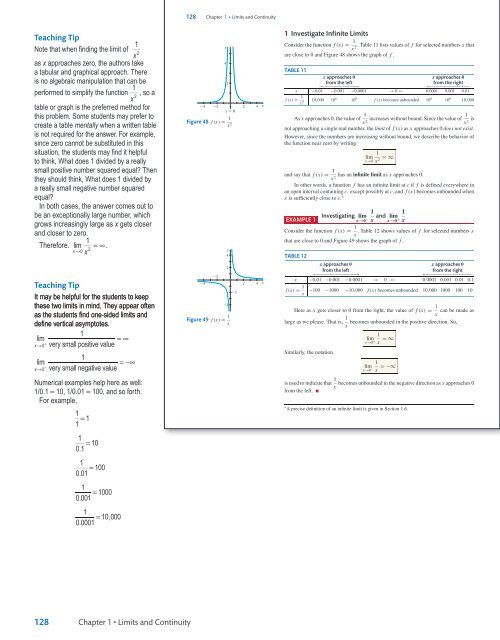Sullivan Microsite DigiSample
Create successful ePaper yourself
Turn your PDF publications into a flip-book with our unique Google optimized e-Paper software.
<strong>Sullivan</strong> AP˙<strong>Sullivan</strong>˙Chapter01 October 8, 2016 17:4<br />
<strong>Sullivan</strong><br />
128 Chapter 1 • Limits and Continuity<br />
Teaching Tip<br />
1<br />
Note that when finding the limit of<br />
x<br />
2<br />
as x approaches zero, the authors take<br />
a tabular and graphical approach. There<br />
is no algebraic manipulation that can be<br />
1<br />
performed to simplify the function , so a<br />
x<br />
2<br />
table or graph is the preferred method for<br />
this problem. Some students may prefer to<br />
create a table mentally when a written table<br />
is not required for the answer. For example,<br />
since zero cannot be substituted in this<br />
situation, the students may find it helpful<br />
to think, What does 1 divided by a really<br />
small positive number squared equal? Then<br />
they should think, What does 1 divided by<br />
a really small negative number squared<br />
equal?<br />
In both cases, the answer comes out to<br />
be an exceptionally large number, which<br />
grows increasingly large as x gets closer<br />
and closer to zero.<br />
Therefore. lim 1 =∞.<br />
x→0<br />
2<br />
x<br />
Teaching Tip<br />
It may be helpful for the students to keep<br />
these two limits in mind. They appear often<br />
as the students find one-sided limits and<br />
define vertical asymptotes.<br />
1<br />
lim<br />
=∞<br />
x→ 0<br />
+ very small positive value<br />
1<br />
lim<br />
=−∞<br />
x→0<br />
− very small negative value<br />
Numerical examples help here as well:<br />
1/0.1 = 10, 1/0.01 = 100, and so forth.<br />
For example,<br />
1<br />
=<br />
1 1<br />
1<br />
=<br />
0.1 10<br />
1<br />
=<br />
0.01 100<br />
1<br />
=<br />
0.001 1000<br />
1<br />
=<br />
0.0001 10,000<br />
y<br />
4<br />
1 Investigate Infinite Limits<br />
Consider the function f (x) = 1 . Table 11 lists values of f for selected numbers x that<br />
x<br />
2<br />
are close to 0 and Figure 48 shows the graph of f .<br />
Figure 48 f (x) = 1 x 2 As x approaches 0, the value of 1 x increases without bound. Since the value of 1 2 x is 2<br />
not approaching a single real number, the limit of f (x) as x approaches 0 does not exist.<br />
TABLE 11<br />
x approaches 0 x approaches 0<br />
2<br />
from the left<br />
−−−−−−−−−−−−−−−→<br />
from the right<br />
←−−−−−−−−−−−−−−−−<br />
x −0.01 −0.001 −0.0001 → 0 ← 0.0001 0.001 0.01<br />
f (x) = 1 10,000 10 6 10 8 f (x) becomes unbounded 10 8 10 6 10,000<br />
4 2<br />
2 4 x<br />
x 2<br />
x 0<br />
y<br />
4<br />
2<br />
2<br />
4 2 4<br />
4<br />
Figure 49 f (x) = 1 x<br />
2<br />
x<br />
However, since the numbers are increasing without bound, we describe the behavior of<br />
the function near zero by writing<br />
1<br />
lim<br />
x→0 x =∞ 2<br />
and say that f (x) = 1 has an infinite limit as x approaches 0.<br />
x<br />
2<br />
In other words, a function f has an infinite limit at c if f is defined everywhere in<br />
an open interval containing c, except possibly at c, and f (x) becomes unbounded when<br />
x is sufficiently close to c. ∗<br />
EXAMPLE 1<br />
1 1<br />
Investigating lim and lim<br />
x→0 − x x→0 + x<br />
Consider the function f (x) = 1 . Table 12 shows values of f for selected numbers x<br />
x<br />
that are close to 0 and Figure 49 shows the graph of f .<br />
TABLE 12<br />
x approaches 0 x approaches 0<br />
from the left<br />
−−−−−−−−−−−−−−−−→<br />
from the right<br />
←−−−−−−−−−−−−−−−−−<br />
x −0.01 −0.001 −0.0001 → 0 ← 0.0001 0.001 0.01 0.1<br />
f (x) = 1 x<br />
−100 −1000 −10,000 f (x) becomes unbounded 10,000 1000 100 10<br />
Here as x gets closer to 0 from the right, the value of f (x) = 1 can be made as<br />
x<br />
large as we please. That is, 1 becomes unbounded in the positive direction. So,<br />
x<br />
Similarly, the notation<br />
1<br />
lim<br />
x→0 + x =∞<br />
1<br />
lim<br />
x→0 − x = −∞<br />
is used to indicate that 1 becomes unbounded in the negative direction as x approaches 0<br />
x<br />
from the left. ■<br />
∗ A precise definition of an infinite limit is given in Section 1.6.<br />
128<br />
Chapter 1 • Limits and Continuity<br />
TE_<strong>Sullivan</strong>_Chapter01_PART II.indd 11<br />
11/01/17 9:55 am




